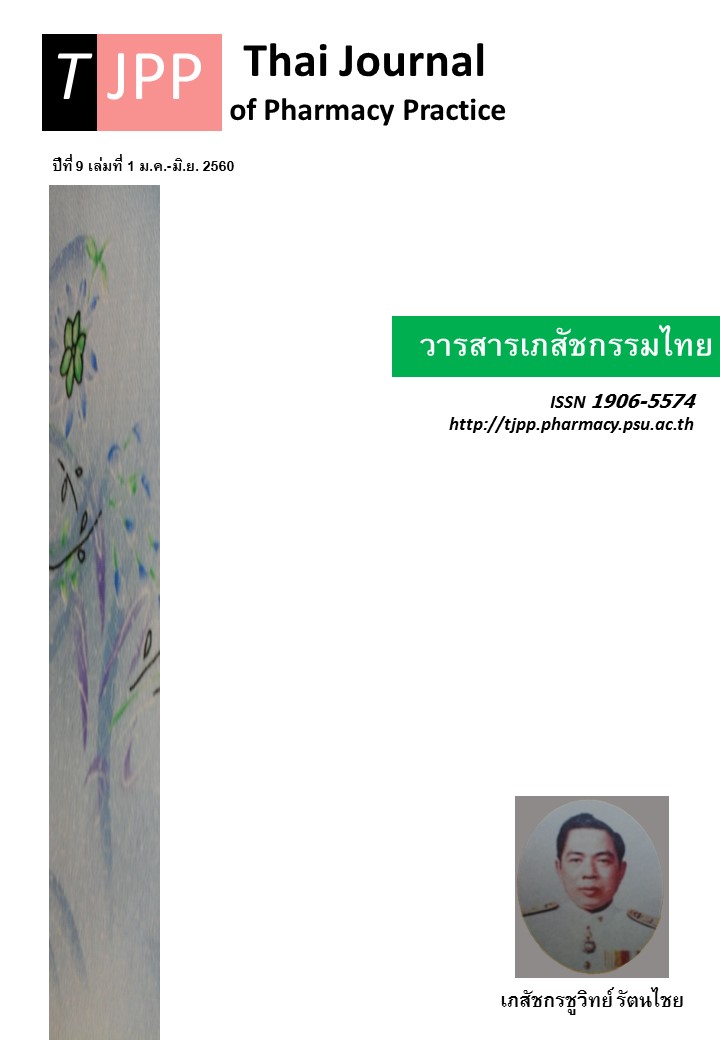ผลของการบริบาลทางเภสัชกรรมต่อคุณภาพชีวิตด้านการบำบัดด้วยยาในผู้ป่วยนอก
Main Article Content
บทคัดย่อ
วัตถุประสงค์: เพื่อศึกษาคุณภาพชีวิตด้านการใช้ยาในกลุ่มผู้ป่วยนอกที่ได้รับการบริบาลทางเภสัชกรรมเปรียบเทียบกับกลุ่มผู้ป่วยนอกที่ไม่ได้รับการบริบาลทางเภสัชกรรม วิธีการ: เป็นการวิจัยเชิงทดลองแบบสุ่มที่มีกลุ่มควบคุมในผู้ป่วยนอก 414 คน ที่รับการรักษา ณ โรงพยาบาลกลางระหว่างเดือนมีนาคม 2559 ถึงเดือนตุลาคม 2559 การศึกษาแบ่งผู้ป่วยออกเป็น 2 กลุ่ม คือ กลุ่มที่ได้รับบริการตามมาตรฐานปกติของโรงพยาบาลและกลุ่มศึกษา การประเมินคุณภาพชีวิตด้านการใช้ยาของผู้ป่วยโดยใช้แบบสอบถาม Patient-reported Outcomes Measure of Pharmaceutical Therapy for Quality of Life (PROMPT-QoL) จำนวน 43 ข้อ ซึ่งแบ่งออกเป็น 9 มิติ ผู้วิจัยเก็บข้อมูล 2 ครั้ง คือ ก่อนการแทรกแซงและหลังการแทรกแซงเมื่อผู้ป่วยกลับมาพบแพทย์ในครั้งถัดไป ผลการวิจัย: ผู้ป่วยกลุ่มที่ได้รับการบริบาลทางเภสัชกรรมมีคะแนนคุณภาพชีวิตด้านการใช้ยาบางมิติดีขึ้นอย่างมีนัยสำคัญทางสถิติเมื่อเทียบกับกลุ่มที่ได้รับบริการตามมาตรฐานปกติ ได้แก่ มิติที่ 2 การได้รับข้อมูลเรื่องยาและโรคจากแพทย์ เภสัชกร หรือพยาบาล (P<0.001) มิติที่ 3 ความพึงพอใจต่อผลของการใช้ยา (P<0.05) มิติที่ 5 ผลทางด้านจิตใจของการใช้ยา (P<0.001) และคะแนนรวมของทั้งแบบสอบถาม (P<0.001) สรุป: การบริบาลทางเภสัชกรรมโดยเภสัชกรส่งผลให้คุณภาพชีวิตด้านการใช้ยาของผู้ป่วยดีขึ้น แบบสอบถาม PROMPT-QoL เป็นเครื่องมือที่ได้มาตรฐานซึ่งสามารถนำมาประเมินคุณภาพชีวิตด้านการใช้ยาได้
Article Details
ผลการวิจัยและความคิดเห็นที่ปรากฏในบทความถือเป็นความคิดเห็นและอยู่ในความรับผิดชอบของผู้นิพนธ์ มิใช่ความเห็นหรือความรับผิดชอบของกองบรรณาธิการ หรือคณะเภสัชศาสตร์ มหาวิทยาลัยสงขลานครินทร์ ทั้งนี้ไม่รวมความผิดพลาดอันเกิดจากการพิมพ์ บทความที่ได้รับการเผยแพร่โดยวารสารเภสัชกรรมไทยถือเป็นสิทธิ์ของวารสารฯ
เอกสารอ้างอิง
2. American Pharmacists A, National Association of Chain Drug Stores F. Medication therapy manage-ment in pharmacy practice: core elements of an MTM service model (version 2.0). J Am Pharm Assoc 2008 ; 48:341-53.
3. Hepler CD, Strand LM. Opportunities and responsibilities in pharmaceutical care. Am J Hosp Pharm 1990;47:533-43.
4. Cipolle RJ, Strand LM, Morley PC. Pharmaceutical care practice: the patient-centered approach to medication management services. 3rd ed. New York: McGraw-Hill; 2012.
5. Singhal PK, Raisch DW, Gupchup GV. The impact of pharmaceutical services in community and ambu-latory care settings: evidence and recommendations for future research. Ann Pharmacother 1999;33:1336-55.
6. Cheng Y, Raisch DW, Borrego ME, Gupchup GV. Economic, clinical, and humanistic outcomes (ECHOs) of pharmaceutical care services for minority patients: a literature review. Res Social Adm Pharm 2013; 9:311-29.
7. Sakthong P, Suksanga P, Sakulbumrungsil R, Winit-Watjana W. Development of Patient-reported Outcomes Measure of Pharmaceutical Therapy for Quality of Life (PROMPT-QoL): A novel instrument for medication management. Res Social Adm Pharm 2015;11:315-38.
8. Kheir NM, Mil JWFv, Shaw JP, Sheridan JL. Health-related quality of life measurement in pharma-ceutical care targeting an outcome that matters. Pharm World Sci 2004;26:125-8.
9. Greenhalgh J, Long AF, Flynn R. The use of patient reported outcome measures in routine clinical practice: lack of impact or lack of theory? Soc Sci Med 2005; 60:833-43.
10. Valderas JM, Kotzeva A, Espallargues M, Guyatt G, Ferrans CE, Halyard MY, et al. The impact of measuring patient-reported outcomes in clinical practice: a systematic review of the literature. Qual Life Res 2008;17:179-93.
11. Viswanathan M, Kahwati LC, Golin CE, Blalock SJ, Coker-Schwimmer E, Posey R, et al. Medication therapy management interventions in outpatient settings: a systematic review and meta-analysis. JAMA Intern Med 2015;175:76-87.
12. Mohammed MA, Moles RJ, Chen TF. Impact of pharmaceutical care interventions on health-related quality-of-life outcomes: A systematic review and meta-analysis. Ann Pharmacother 2016;50:862-81.
13. Murawski MM, Bentley JP. Pharmaceutical therapy-related quality of life: conceptual develop- ment. J Soc Adm Pharm 2001;18:2-14.
14. Ernst ME, Iyer SS, Doucette WR. Drug-related problems and quality of life in arthritis and low back pain sufferers. Value Health 2003;6:51-8.
15. Renberg T, Lindblad AK, Tully MP. Testing the validity of a translated pharmaceutical therapy-related quality of life instrument, using qualitative 'think aloud' methodology. J Clin Pharm Ther 2008;33:279-87.
16. Krska J, Morecroft CW, Poole H, Rowe PH. A novel instrument to measure medicines-related quality of life. Int J Clin Pharm 2013;35:488.
17. Krska J, Morecroft CW, Rowe PH, Poole H. Measuring the impact of long-term medicines use from the patient perspective. Int J Clin Pharm 2014; 36:675-8.
18. Nontapat Sonsa-ardjit. Psychometric properties of the Patient-reported Outcome Measure of Pharma-ceutical Therapy: Quality of Life (PROMPT-QoL) at King Chulalongkorn Memorial hospital [dissertation]. Bangkok: Chulalongkorn University; 2014.
19. Pattarin Sukarnjanaset. Psychometric properties of the Patient-reported Outcome Measure of Pharma-ceutical Therapy: Quality of Life (PROMPT-QoL) at Ramathibodi hospital [dissertation]. Bangkok: Chulalongkorn University; 2014.
20. Wipaporn Munpan. Psychometric properties of the Patient-reported Outcome Measure of Pharmaceutical Therapy: Quality of Life (PROMPT-QoL) at Phramong kutklao hospital [dissertation].Bangkok: Chulalongkorn University; 2014.
21. Athipat Cleesuntorn. Education in Thailand and the challenging issues [online]. 2016 [cited Jan 8, 2017]. Available from: www.en.moe.go.th/index.php? option=com_content&view=article&id=3660:education-in-thailand-and-the-challenging-ssues&catid=23:article.
22. Faul F, Erdfelder E, Buchner A, Lang AG. Statistical power analyses using G*Power 3.1: tests for correlation and regression analyses. Behav Res Methods 2009; 41:1149-60.
23. Cohen J. Quantitative methods in psychology; a power primer. Psychol Bull 1992;112: 155-9.
24. Cohen HJ. Statistical power analysis for the behavioral sciences. Hillsdale, NJ: Erlbaum; 1988.
25. Crawford SD, Couper MP, Lamias MJ. Web surveys: perceptions of burden. Soc Sci Comput Rev 2001;19:146-62.
26. Bernsten C, Bjorkman I, Caramona M, Crealey G, Frokjaer B, Grundberger E, et al. Improving the well-being of elderly patients via community pharmacy-based provision of pharmaceutical care. Drugs Aging 2001;18:63-77.
27. Butt M, Mhd Ali A, Bakry MM, Mustafa N. Impact of a pharmacist led diabetes mellitus intervention on HbA1c, medication adherence and quality of life: A randomised controlled study. Saudi Pharm J 2016; 24 : 40-8.
28. Clifford RM, Batty KT, Davis TME, Davis W, Stein G, Stewart G, et al. A randomised controlled trial of a pharmaceutical care programme in high-risk diabetic patients in an outpatient clinic. Int J Pharm Pract 2002; 10:85-9.
29. Cohen LB, Taveira TH, Khatana SA, Dooley AG, Pirraglia PA, Wu WC. Pharmacist-led shared medical appointments for multiple cardiovascular risk reduction in patients with type 2 diabetes. Diabetes Educ 2011;37:801-12.
30. Hanlon JT, Weinberger M, Samsa GP, Schmader KE, Uttech KM, Lewis IK, et al. A randomized, controlled trial of a clinical pharmacist intervention to improve inappropriate prescribing in elderly out-patients with polypharmacy. Am J Med 1996; 100: 428-37.
31. Jaeschke R, Singer J, Guyatt GH. Measurement of health status: ascertaining the minimal clinically important difference. Control Clin Trials 1989; 10: 407-15.
32. Crosby RD, Kolotkin RL, Williams GR. Defining clinically meaningful change in health-related quality of life. J Clin Epidemiol 2003; 56: 395-407.


